Why Robot Modularity Is So Evasive, But Also Inevitable
Let's talk about both the challenges and promise of Robot Modularity
Aaron’s Thoughts On The Week
"Progress is impossible without change, and those who cannot change their minds cannot change anything." — George Bernard Shaw
Robotics is advancing at an unprecedented pace, yet one fundamental challenge remains: modularity. The ability to swap, upgrade, and reuse robotic components seamlessly could revolutionize the industry, making robots more adaptable, cost-efficient, and sustainable. However, despite its clear advantages, widespread modularity has yet to take hold. Companies often prioritize proprietary systems over interoperability, while technical hurdles and a lack of industry-wide standards further slow progress.
The European Union's mandate for USB-C standardization in mobile devices is a striking example of modularity being enforced rather than adopted naturally. This raises the question: Should similar regulatory efforts be applied to robotics, or can the industry evolve toward modularity on its own? Let’s discuss that.
What is Robot Modularity?
Robot modularity refers to the design philosophy of building robots using interchangeable components that can be easily replaced, upgraded, or repurposed. This can apply to both hardware (such as arms, sensors, or locomotion units) and software (such as modular AI algorithms, navigation systems, or perception modules). In an ideal modular system, different robotic platforms could share universal components, making them more adaptable, cost-effective, and sustainable over time.
Modularity is already a standard in some areas of robotics. Industrial robots often have modular end effectors, allowing a single robotic arm to switch between welding, painting, or material handling tasks. Similarly, modular software architectures enable robots to be updated with new capabilities without redesigning the entire system. However, modularity remains more of an exception than the rule, especially in some of robotics' newest applications.
Why is Modularity Important?
Cost Efficiency—Modular robots help businesses cut costs by allowing them to replace or upgrade individual components rather than purchasing entirely new systems. This significantly reduces downtime, maintenance costs, and capital expenditures. A factory investing in modular robotic arms, for instance, could swap out grippers, vision systems, or actuators as technology improves rather than replacing the entire robot. This model extends the robot's lifespan and ensures companies can keep up with emerging automation trends without constant reinvestment in new hardware. Additionally, predictive maintenance powered by modular systems can prevent unexpected failures, reducing operational disruptions.
Flexibility and Adaptability—In dynamic industries like warehouses, healthcare, and construction, robots must perform various tasks while adapting to new challenges. Modular robots enhance adaptability by allowing quick component swaps, enabling them to handle different functions without needing an entirely new platform. For example, an autonomous mobile robot (AMR) in a warehouse could transition from transporting packages to performing inventory scans just by changing its sensor suite. This adaptability ensures businesses future-proof their robotic investments while keeping up with industry demands.
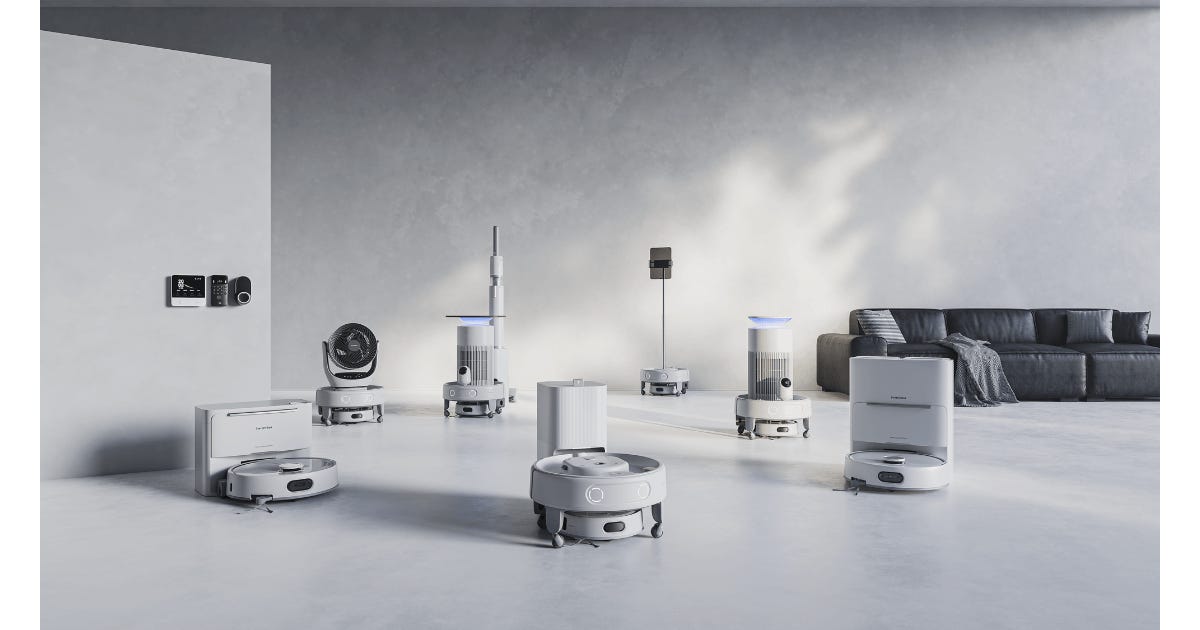
Sustainability – The rapid turnover of robotic systems creates significant electronic waste, contributing to environmental concerns. Modular robotics aligns with circular economy principles by extending the lifespan of robotic hardware. Instead of discarding entire robots, businesses can replace worn-out or outdated components, reducing waste and conserving resources. Companies can also recycle or repurpose modular components, further reducing their carbon footprint. Governments and regulatory bodies are pushing for more sustainable manufacturing practices, and modular robotics plays a key role in achieving these eco-friendly goals.
Interoperability – In large automated facilities, multiple robotic systems from different manufacturers must work together efficiently. Interoperability through modularity allows robots to share components, communication protocols, and power systems, making large-scale automation more cost-effective and scalable. Standardized modules also enable businesses to integrate new robotic solutions without reconfiguring entire systems. By embracing modular interoperability, manufacturers can increase efficiency and simplify maintenance, leading to seamless collaboration between robots from different brands.
Faster Innovation—Modular robotics accelerates technological advancements by encouraging an open innovation approach. Instead of companies developing closed, proprietary systems, modular designs allow different manufacturers and researchers to collaborate, share components, and build upon existing platforms. This fosters an environment of continuous improvement, reducing the time it takes for new robotics technologies to reach the market. Additionally, modular platforms allow for quick prototyping, meaning developers can test and refine new features without building entirely new robotic systems from scratch.
The Reality: Why Robotics Struggles to Commit to Modularity
Despite these clear advantages, widespread modularity remains elusive in robotics. This resistance stems from economic, technical, and strategic challenges.
Proprietary Business Models—Like smartphone makers who once clung to proprietary charging ports, robotics companies have a vested interest in keeping ecosystems closed. Selling full robotic systems rather than individual components ensures a steady revenue stream, but this business model disincentivizes the development of interchangeable components across brands.
For instance, large industrial robot manufacturers often use proprietary control software that limits interoperability between their robots and third-party hardware. This lack of standardization forces customers into vendor lock-in, discouraging modularity in favor of all-in-one solutions.
Technical Complexity—Unlike PCs or mobile phones, where modularity is relatively straightforward, robots integrate mechanical, electronic, and software components that must work in perfect harmony. Even slight variations in a module’s design can create performance issues.
For example, swapping out an autonomous mobile robot’s (AMR) sensor suite isn’t as simple as replacing a smartphone camera. The new sensor may require recalibration, reprogramming, or even modifications to the robot’s mechanical structure to function correctly. This complexity makes truly plug-and-play modularity much harder to achieve.
Lack of Industry-Wide Standards—Unlike consumer electronics, where USB-C has become a unifying standard, robotics lacks a universal hardware or software standard for modularity across numerous robot types. While some robots in some sectors do follow modularity for their sector, only those robots are impacted. Efforts like ROS (Robot Operating System) have made strides in software standardization, but hardware remains fragmented.
Take robot batteries, for example. Unlike consumer devices, where a single USB-C charger can power multiple brands, robots from different manufacturers often require brand-specific charging stations and connectors. This lack of standardization makes interoperability expensive and impractical.
The EU’s USB-C Mandate: A Lesson in Enforcing Modularity
The European Union’s decision to mandate USB-C charging for all new mobile devices by 2024 was a landmark case of forcing modularity when industries resist it. This regulation ensured that consumers no longer need different chargers for different brands, reducing e-waste and increasing convenience.
Could a similar approach work for robotics? Theoretically, yes. Governments or industry groups could enforce standardization in areas like battery interfaces, robotic communication protocols, or even modular end effectors. A universal robotic charging standard alone could dramatically reduce costs and improve efficiency in sectors using multiple robot brands.
However, enforcing modularity in robotics is far more complex than in consumer electronics. While a phone’s charging system is relatively uniform, robots are designed for vastly different applications—ranging from delicate surgical robots to heavy-duty construction bots. Any regulatory push toward modularity would need to balance flexibility with standardization, ensuring companies can still innovate while adhering to common frameworks.
The Path Forward: Encouraging Organic Modularity
While regulatory mandates are unlikely in the near term, the best way to drive modularity in robotics will be through industry collaboration and customer demand. Several factors could accelerate adoption:
Market Pressure – As companies realize the cost benefits of modularity, customer demand may push manufacturers toward standardized designs. For example, logistics giants like Amazon and DHL, which rely on multi-brand robotic fleets, could demand modular components to improve scalability and serviceability.
Open-Source Hardware – While software standardization has progressed with ROS, open-source hardware initiatives could encourage more cross-company compatibility. Projects like Open Robotics or ROS-Industrial are already working toward this goal.
Industry Consortia – Groups like the International Federation of Robotics (IFR) or IEEE Robotics and Automation Society could play a role in setting voluntary modularity standards, much like USB-IF did for charging ports.
Economic Incentives – Governments could incentivize modular design through tax credits or grants for companies developing robots with reusable, upgradeable components.
So Will We Have A Modular Future?
Robot modularity offers clear benefits in cost, flexibility, sustainability, and innovation, yet it remains an underutilized approach due to economic interests, technical challenges, and the lack of standardization. The EU’s push for USB-C shows that modularity can be enforced if industries don’t move fast enough, raising the question of whether robotics could see a similar regulatory intervention.
For now, organic industry shifts, open-source initiatives, and customer-driven demand may be the best path toward mainstreaming modular robotics. If robotics manufacturers embrace modularity voluntarily, they stand to gain not just efficiency and sustainability but also market competitiveness—because the future of robotics isn’t just about intelligence but also interchangeability.
If you would like to contribute to the ongoing discussion around modularity and interoperability, the team at ARIA in the United Kingdom is conducting a survey to gather more data on what future steps in modularity could look like. Click here to take the survey.
Robot News Of The Week
Apptronik raises $350 million to scale production of humanoid robots
Apptronik has raised $350 million in Series A funding, co-led by B Capital and Capital Factory, with participation from Google, to accelerate development of its Apollo humanoid robot. Since its 2016 founding at UT Austin’s Human Centered Robotics Lab, the company has raised $378 million.
CEO Jeff Cardenas emphasized that while humanoids may enter homes and healthcare in the future, logistics and manufacturing are the best starting points due to their structured environments. Mercedes-Benz and GXO Logistics are already testing Apollo in real-world applications.
This funding adds to the wave of investment in humanoid robotics, with Figure AI raising $854M, Agility Robotics securing $178M+, and 1X Technologies amassing $136.5M.
FANUC’s industrial robot sales drop 16%
FANUC, a leading industrial robotics company, is experiencing a slowdown due to global economic uncertainty. For the first nine months of its fiscal year (April–December 2024), robot sales fell 16.4% to approximately $1.63 billion, largely due to weaker demand in China, Europe, and the Americas, particularly in the automotive sector. However, demand remained strong in Japan’s general industries.
Despite declining robot sales, FANUC’s factory automation division saw a 10% increase, reaching $990 million, driven by strong CNC system sales in India and China. Its ROBOMACHINE division grew 21.8% to $623 million, with gains in ROBODRILLs and ROBOSHOTs offsetting a slight drop in ROBOCUT sales.
Total consolidated sales for the period declined 1.9% to $3.94 billion, but ordinary income rose 3.2% to $940 million, and net income increased 4.5% to $693 million. These results led FANUC to slightly raise its sales and income forecasts for the full fiscal year.
The company continues to innovate, launching its R-50iA robot controller in late 2024 and a new collaborative robot last year. In July 2024, FANUC America Corp. opened a 650,000-square-foot West Campus in Auburn Hills, Michigan.
The slowdown in robotics is part of a broader trend. China, the world’s largest industrial robotics market for over a decade, saw its first decline in industrial robot sales in five years, with total deliveries down 5% in 2024. North America also experienced stagnation after record growth in 2021 and 2022. The Association for Advancing Automation expects a slow start to 2025 before a potential rebound in the second half of the year.
Carbon Robotics releases new line of laser weed-zappers for more types of farms and budgets
Seattle-based Carbon Robotics has launched the LaserWeeder G2, an upgraded version of its AI-powered robotic weeder, designed to zap weeds faster and more efficiently across a wider range of crops. The G2 is lighter, modular, and up to twice as fast as the original, offering sizes from 6.6 to 60 feet to accommodate different farm needs.
Founded in 2018, Carbon Robotics’ technology attaches to tractors, using AI, computer vision, and laser precision to eliminate weeds without disturbing soil microbiology. The LaserWeeder G2 relies on Nvidia GPUs, processing 4.7 million images per hour and drawing from a 40-million-plant dataset spanning three continents. The company has eliminated over 15 billion weeds across 250,000 acres and 100+ crops.
Robot Research In The News
Neuromechanics-inspired control solution boosts robot adaptability
Robots often struggle in real-world environments, where they need to quickly adjust movements based on surroundings. Researchers from the University of Granada and EPFL have developed a new neuromechanics-inspired control system that helps robots adapt more like humans.
Their approach mimics how the central nervous system and muscles work together. The system has two key components: a muscle model and a cerebellar network. The muscle model copies how human muscles work in pairs, adjusting stiffness for different tasks. The cerebellar network helps robots learn and adapt based on experience, similar to muscle memory.
This method eliminates the need for complex math or expensive sensors, allowing robots to safely interact with humans and handle unpredictable tasks. Tests showed that robots using co-contraction improved movement accuracy and resilience against disruptions. Training under low stiffness conditions also reduced learning time and wear and tear.
The researchers plan to enhance the system with AI-driven learning and develop new robotic hardware that integrates co-contraction directly into its design. Their work could lead to more versatile robots for industries like manufacturing, healthcare, and service robotics.
Dual-Arm HyQReal Puts Powerful Telepresence Anywhere
Robots are ideal for working in dangerous environments, but they often struggle without human supervision. To solve this, researchers at the Italian Institute of Technology (IIT) developed a teleoperated quadruped robot with powerful arms, allowing humans to remotely control it for complex tasks in hazardous areas.
The robot, HyQReal, is a 140-kg hydraulic quadruped known for its strength—it once pulled a three-ton airplane. Its battery-powered hydraulic system provides 4 kilowatts of power, making it strong and stable. Mounted on its "head" are two IIT-INAIL robotic arms, each weighing 10 kg and capable of lifting 5 kg. Unlike many robots, its overlapping arm workspace allows for bimanual manipulation, aided by its flexible body movements.
IIT also developed an immersive VR-based teleoperation system that lets users control the robot naturally without worrying about joint limits. The system uses smart haptic feedback and optimized video transmission, ensuring smooth operation.
By combining human intelligence with robotic power, this project expands robot capabilities for industries like disaster response and heavy-duty automation, making dangerous tasks safer and more efficient.
Robot Workforce Story Of The Week
He went into outer space, now he is training the next generation of roboticists.
Robot Video Of The Week
We are seeing more in the general public uploading videos of their first interactions with delivery robots. Some are positive and some are negative. This one got attention this week, just for how positive it was.
Upcoming Robot Events
Feb. 24-26 Intl. Conference on Mechatronics and Robotics Engineering (Lille, FR)
Mar. 4-6 Intl. Conference on Human-Robot Interaction (Melbourne)
Mar. 17-21 NVIDIA GTC AI Conference (San Josa, CA)
Mar. 21-23 Intl. Conference on Robotics and Intelligent Technology (Macau)
Mar. 25-27 European Robotics Forum (Stuttgart)
Apr. 23-26 RoboSoft (Lausanne, Switzerland)
Apr. 30-May 1 Robotics Summit (Boston, MA)
May 12-15 Automate (Detroit, MI)
May 17-23 ICRA 2025 (Atlanta, GA)
May 18-21 Intl. Electric Machines and Drives Conference (Houston, TX)
May 20-21 Robotics & Automation Conference (Tel Aviv)
May 29-30 Humanoid Summit - London
June 30-July 2 International Conference on Ubiquitous Robots (College Station, TX)
Aug. 18-22 Intl. Conference on Automation Science & Engineering (Anaheim, CA)
Oct. 6-10 Intl. Conference on Advanced Manufacturing (Las Vegas, NV)
Oct. 15-16 RoboBusiness (Santa Clara, CA)
Oct. 19-25 IEEE IROS (Hangzhou, China)
Nov. 3-5 Intl. Robot Safety Conference (Houston, TX)
Dec. 11-12 Humanoid Summit (Silicon Valley TBA)


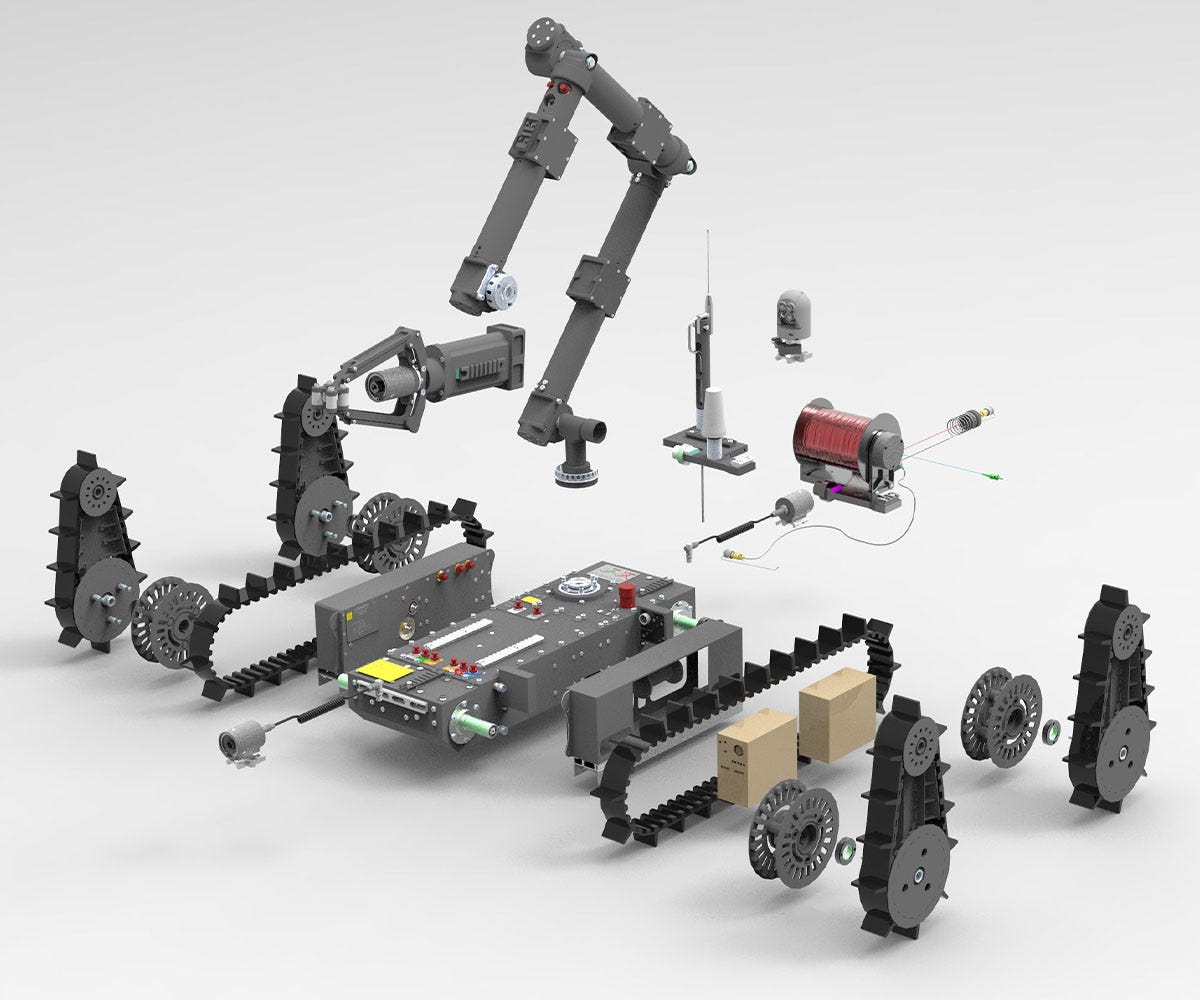
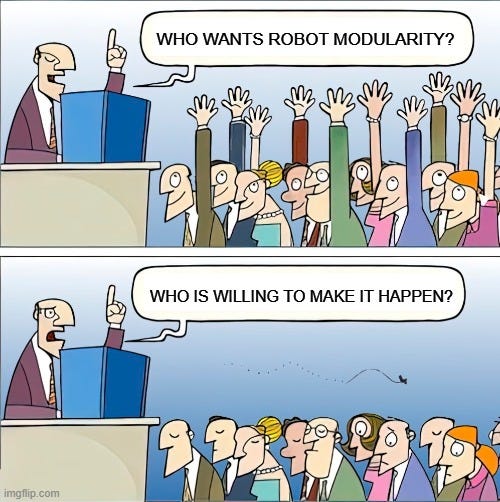

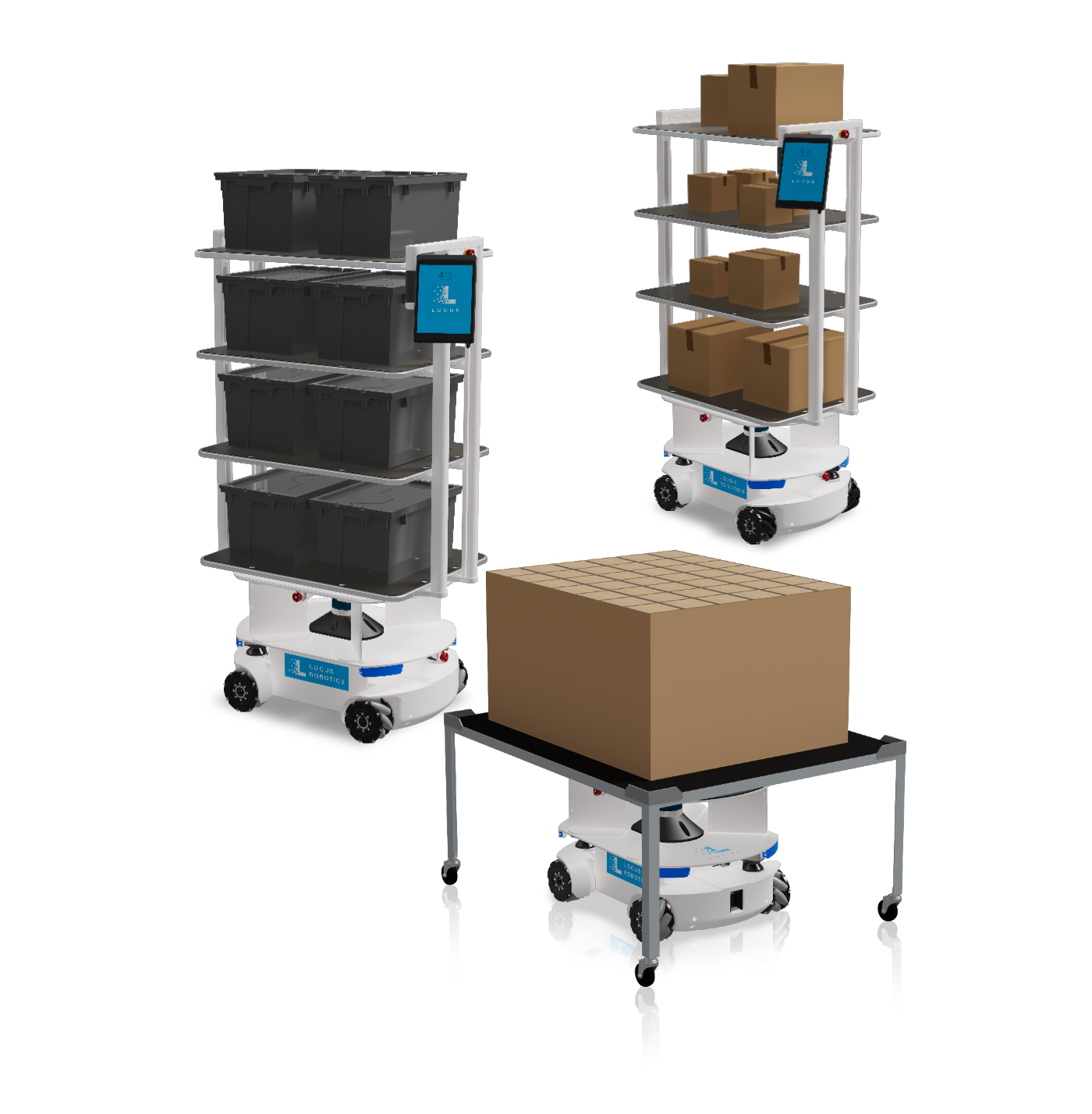
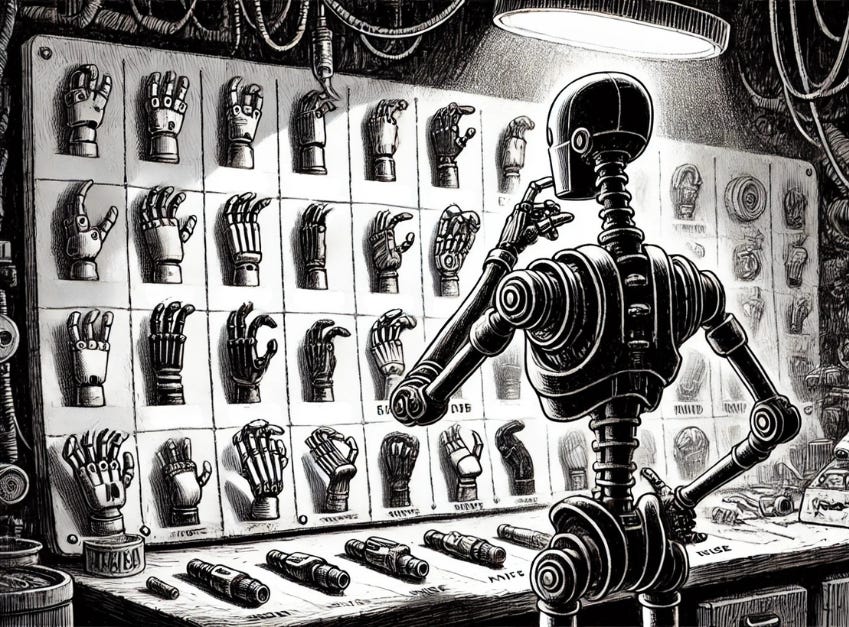
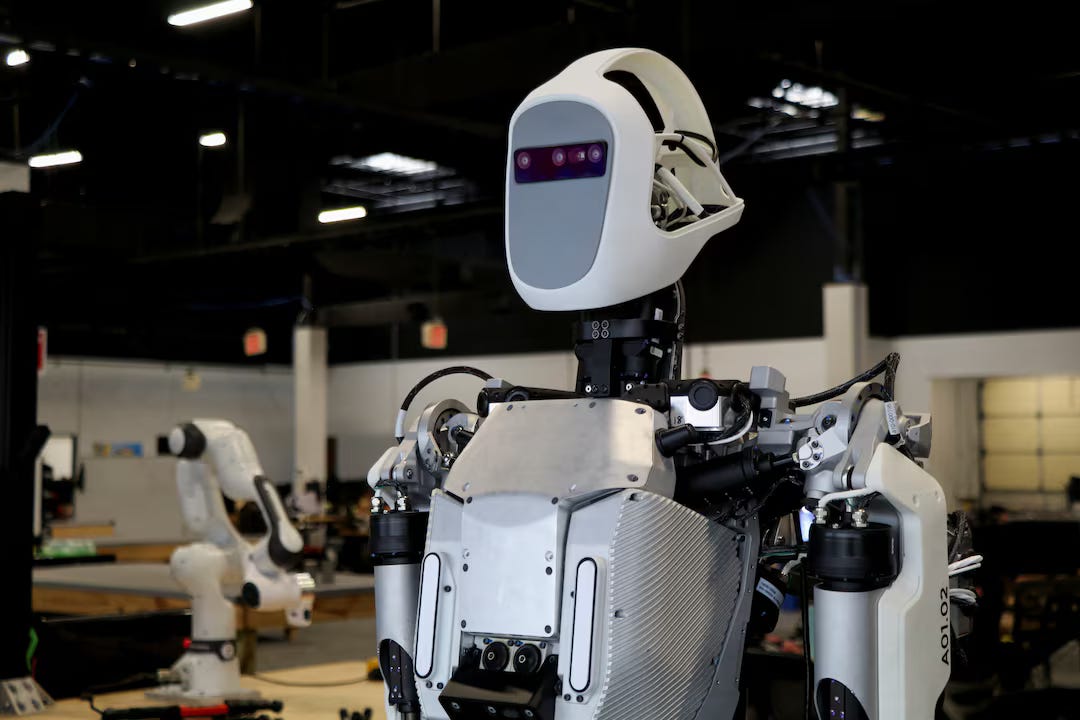
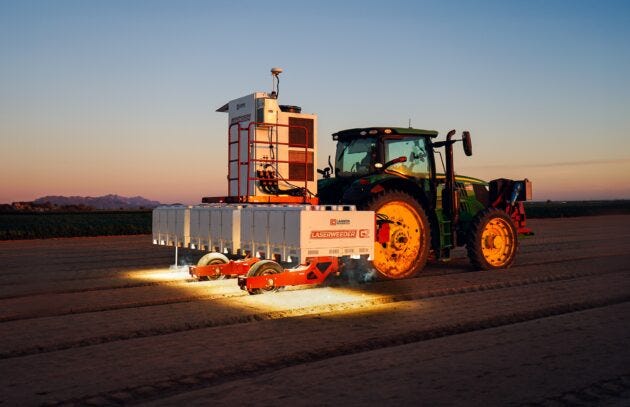
Love it! The image of the exploded mobile base looks a lot like some of renderings in HEBI proposals :) True modularity is very difficult, given the complexities of robots and the limitless number of tools and sensors that need to be deployed in the nearly limitless number of workspaces and environments. It is a vision well worth pursuing, and the world of robotics will get there in time!